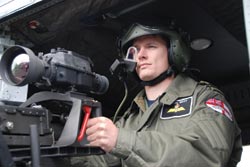Whether in a helicopter or fixed-wing aircraft, or whether hunting for insurgents in Afghanistan or lost children on a mountain slope near Denver, pilots of all stripes are putting in more hours than ever after the sun sets. Night-vision goggles, or NVGs, have been making such missions – and many more – possible for years, but where is the technology heading?
The heart of an NVG system is an electro-optical image intensifier. Akin to a photomultiplier tube, the image intensifier takes in whatever light is available – even in what appears to the eye as complete darkness – and converts the incoming photons into electrons. These electrons are rapidly replicated and sent to a display – often, the eyepieces in a set of goggles mounted onto the aviator’s helmet but, sometimes, onto a separate screen.
Military operations around the world have embraced night-vision technology wholeheartedly. Recently, the Australian Defence Force, through its chief contracting firm Australian Aerospace, began an upgrade program that will refit 46 Tiger helicopters with TopOwl helmet-mounted night-vision systems. TopOwl systems are produced by Thales Group, which has sold them to military contractors in more than a dozen countries, including the US and Spain.
TopOwl is geared for use by helicopter pilots, but the company also makes TopSight, a similar system for fixed-wing aviators.
In addition, the UK’s Ministry of Defence has placed an order for a dozen Q-Sight systems, helmet-mounted displays made by BAE Systems. Complementary to NVGs, the Q-Sight displays are flexible adjuncts that enable use of image intensification, thermal (near-IR) vision and overlaid tactical information via specialized symbols that light up on the display surface. The technology takes advantage of holographic waveguides that transmit light from various sources to the main screen, which is mounted onto the pilot’s helmet.

Night-vision goggles and related technology are becoming ubiquitous in the military, but what about the civilian markets? Courtesy of BAE Systems.
“Everyone wants the latest, greatest technology,” said Mike Atwood of ASU (Aviation Specialties Unlimited) Inc., a night-vision technology company in Boise, Idaho. But “the [technologies] we have now will be around for a long time.”
Military and security end users have nearly maxed out the technological limits of NVGs. The standard field of view of the devices is a rock-solid 40°; any larger, and they get prohibitively expensive.
“There are a small number of large-field-of-view systems used in the military because they’re the only ones who can afford them,” Atwood said. “Most would take panoramic systems if they could, but getting them at an affordable price won’t come about for years, if ever.”
A wider vista
Panoramic systems – providing 100° or more of coverage – would give pilots more vista to view but also would enable them to keep their eyes forward and avoid swiveling their heads to scan a scene.
Other factors that directly affect aviators are the size and weight of NVG systems. Helmet-mounted packages have shrunk somewhat over the past 20 years, but they still are bulky and weighty enough for fliers who occasionally hit speeds that ramp up the g forces. Extra weight equals extra strain on head and neck muscles, plus there is an increased danger from the equipment in the event of a crash.
Although NVGs and other night-vision systems have had a robust life in the armed services, growth in the market is coming from civilian aviation; specifically, search-and-rescue missions, emergency medical services, police and fire use, aerial insecticide applications, transportation to oil rigs and other dark, dangerous areas, and more. As more military pilots with night-flying experience leave the service for civilian life, a growing number of aviators are looking to fill niches where they can put those skills to good use.
What has kept the market from flooding with night-flying pilots and their NVGs isn’t the technology itself – advances have kept up with the industry. Instead, the hurdle has been getting regulations and guidance in place on how civilian pilots should be trained in the practice of night-vision systems.
According to ASU’s Atwood, federal regulations were drafted as far back as 2000 but only recently enacted as part of Title 14, CFR Chapter 1, Part 61. Now that firm guidelines are in place for training and operating aircraft with NVGs and the like, a virtual explosion of civilian pilots – albeit, highly specialized ones – are expected to adapt to night flying.
“Night-vision systems are not the panacea for night flying – it can still be too dark for them to operate properly,” Atwood said. “But they are very good at what they do.”